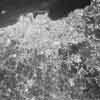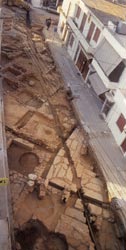Khania
 (Click to enlarge) With kind permission of http://www.si-eu.com/ |
 (Click to enlarge) © Ministry of Culture Archaeological Receipts Fund |
The harbour and adjacent hill now called Kastelli have been exploited since Prehistoric times. Excavations of a site that has been inhabited continuously for 5000 years are naturally difficult: the ‘windows’ available to archaeologists are limited, and their availability rather random. But Greek-Swedish excavations of a site on the Kastelli hill have uncovered evidence for a major Minoan settlement here.
 Kastelli, Khania, Greek-Swedish excavations. © Ministry of Culture Archaeological Receipts Fund |
These and other excavations in Khania, by the local archaeological Ephoreia (Department), have shown that Khania was the most important Minoan site in western Crete.
 Daskaloyianni Street, Khania. 1997 excavations. © Kapon |
It is to be identified with the place called Kydonia in a Linear B tablet from Knossos. From Khania itself there is now evidence for palatial-style record keeping, namely Linear A and Linear B tablets and seals.
As elsewhere on Crete, there was a period of disruption at the end of the Minoan period, but evidence for people at Khania begins again in the tenth century. The site, still known as Kydonia, became by the Classical period the major polis in western Crete. A tradition developed that it was one of the three poleis on Crete founded by Minos, which indicates the survival of a memory of its Prehistoric past. The remains of the Hellenistic and Roman periods are the best preserved, though as for the Minoan remains they are largely still concealed (or destroyed) by later buildings. There are traces of temples from the Archaic period, some fine Roman mosaics from houses in Khania, and numerous graves.
 Mosaic floor showing Poseidon and the nymph Amymone. Third century AD. © Ministry of Culture Archaeological Receipts Fund |
The Roman theatre survived until Venetian times, when according to Onorio Belli it was demolished so that material from it could be used to build the outer fortifications of Khania.
 Byzantine fortifications of Khania, showing reused Roman materials. (1999) © Lucia Nixon |
The history of the city in the Byzantine period is not well understood, but, as at Gortyn, a wall was built round the base of the Kastelli hill, using (as the Venetians were to do) blocks from ancient buildings.
There was certainly a flourishing city at Khania when the Venetians arrived.